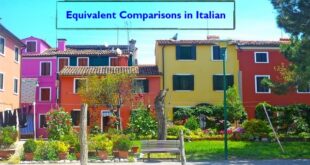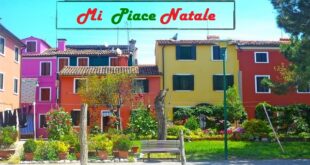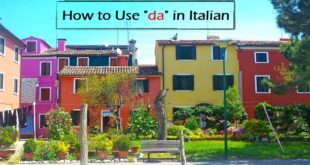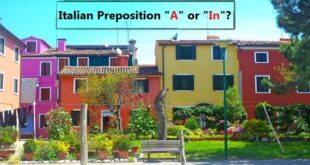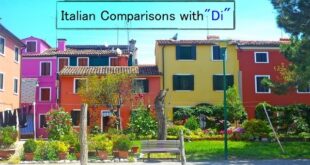Over the centuries, writers have pondered the question, “Che cos’è l’amore?” “What is love?” And since the Italian poet Petrarch expressed his great love for Laura in the 14th century, love poems have often taken the form of he used — the sonetto, or sonnet. These “little songs” are 14 lines long and follow a specific rhythm and rhyme scheme. When Shakespeare took up the sonnet in the 16th Century, he changed Petrarch’s form and made it his own; Shakespeare used the sonnet to write some of the most famous lines about love in existence today. Shakespeare’s contemporaries and many poets who …
Read More »Equivalent Comparisons
Every day, we all compare the characteristics of one person, place or thing to another — and many times these characteristics are similar or the same. For instance, there are so many places in Italy that are beautiful, and one may be as beautiful as another! Or one place in Italy may have as many important sites of interest as another. In these cases, to make a comparison we must use the Italian adverbs come and tanto… quanto to relay the meanings “as,” “as well as,” and “as much as.” When comparing two different nouns — people, places, or things …
Read More »Mi Piace Natale
How to Say, “I like…” in Italian with “Mi Piace” In a previous blog on this topic, Using Piacere to say, “I like it!” we learned: The Italian verb piacere literally means “to be pleasing.” Italians use this verb when they want to express the idea that they like something. It is how Italians say, “I like it!” It should first be noted that piacere has an irregular conjugation. Then, it is important to understand that the verb piacere works differently than most other Italian verbs that have an -ere ending. In effect, the subject of the sentence that uses the verb piacere …
Read More »How to Use “Da” in Italian
Let’s continue our series about Italian prepositions with the essential Italian preposition “da.” The Italian preposition da can be translated into the English prepositions “from” and “by.” It serves as an essential link between Italian nouns, is used in Italian phrases that describe time in a complex way, and is also integral to many common expressions. If we learn how to use the Italian preposition da, we will truly sound like a native Italian! Use “Da” to Say Where You are From One of the most frequent questions asked during polite conversation is, “Where are you from?” We learned how to …
Read More »Being Polite with “Potere”
Potere means “to can” or “to be able to,” and is classified as a modal, or helping verb. This means that potere provides information about the ability of the speaker to “be able to” complete the main action described in a sentence. When used in this way, potere is conjugated to reflect the speaker and the action verb follows directly after in its infinitive form — that is, the action verb is not conjugated! (Remember that Italian verbs are categorized into three infinitive forms by the following endings: -are, -ere, and -ire, and that English infinitive verbs are preceded by …
Read More »Tag teaming two past tenses
Combining the Imperfetto with the Passato Prossimo Choosing an Italian Past Tense Let’s start our blog about how to combine the imperfetto with the passato prossimo by reviewing some general rules of Italian grammar. We learned in “Picking an Italian Past Tense” that the circumstances surrounding the event will determine which Italian past tense to use. Luckily, imbedded in many Italian sentences about past events are certain words and phrases that will indicate whether the imperfetto or the passato prossimo is needed. The intent of the speaker will be signaled by these phrases, which will then trigger use of the correct …
Read More »Imperfetto or Passato Prossimo?
Imperfetto or Passato Prossimo? Previous blogs in this series have discussed the basics of how to conjugate and use the imperfetto and the passato prossimo to speak about the recent past.* As we’ve mentioned before, the conjugation of these verb forms is fairly straightforward; the tricky part is knowing which past tense to choose to describe a particular event. To make matters more complex, a compound sentence can be created using only the imperfetto, only the passato prossimo, or a combination of both. And in many situations, the same event can be described in Italian using either the imperfetto …
Read More »Italian Preposition “a” or “in”?
The Italian “a” can be translated as both “to” or “in” in English. The Italian “in” is translated the same as in English — “in”! Both prepositions “a“ and “in“ can be used to describe where someone is going and where a person of thing is located. But each preposition has its own particular role to play to fulfill this function. If we learn how to use the Italian prepositions “a” and “in” correctly, we will truly sound like a native Italian!” Use the Italian “a” or “in” for a Country, Region, or City Americans and Italians use the prepositions …
Read More »Making Reservations in Italian
Prior to beginning the lesson for this blog, I acknowledge that in the larger cities of Italy it is not usually necessary to make reservations in Italian; the Italian staff usually speak basic English and often the languages of their European neighbors — French, Spanish or German. Also, of course, in most cases, reservations can now be made over the internet on one’s computer or smart phone, without any human interaction at all! But I’ve found that a few phrases in Italian are always warmly welcomed by Italian servers and hotel receptionists, even in the larger cities, and can serve …
Read More »Comparisons using “di”
To speak fluently in another language, it is important to know how to make comparisons. Every day we all compare the characteristics of one thing to another — larger vs. smaller, older vs. younger, better vs. worse — often while describing what we prefer. The Italian language uses precise sentence structures and specific prepositions when making comparisons that are not always identical to English. In this blog, we will explore several ways to make comparisons that use the Italian preposition di. The good news is that Italian is consistent, and it is easy to learn the “Italian way” of thinking …
Read More » Fra Noi Embrace Your Inner Italian
Fra Noi Embrace Your Inner Italian


